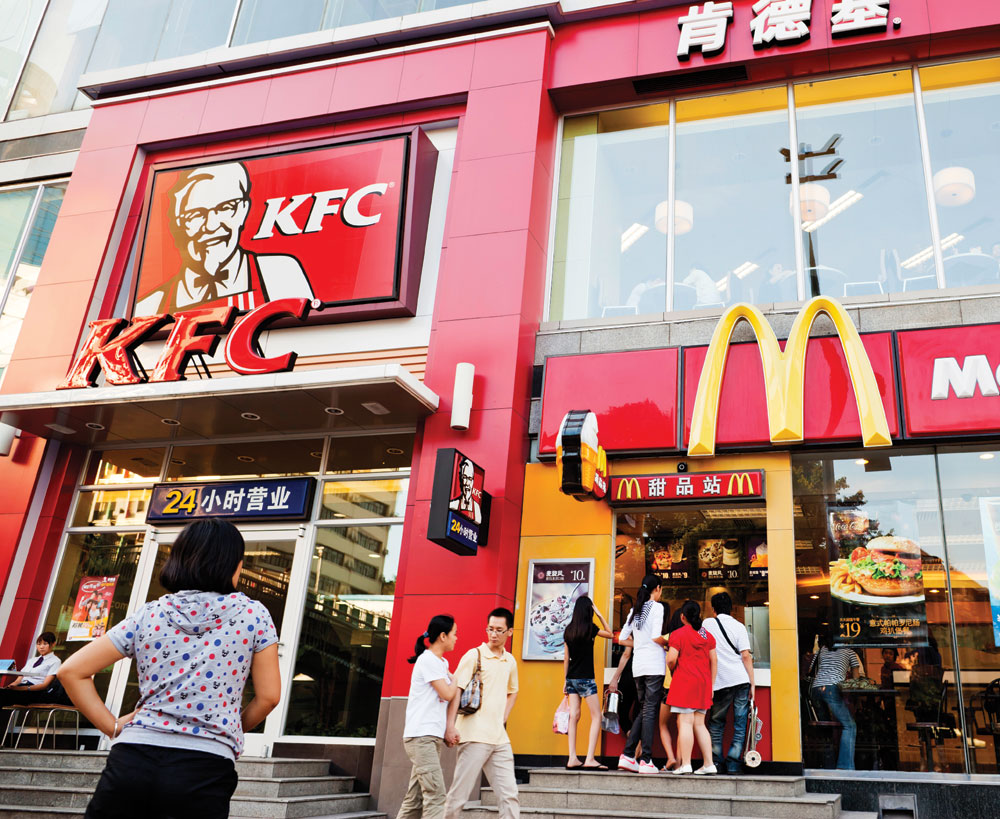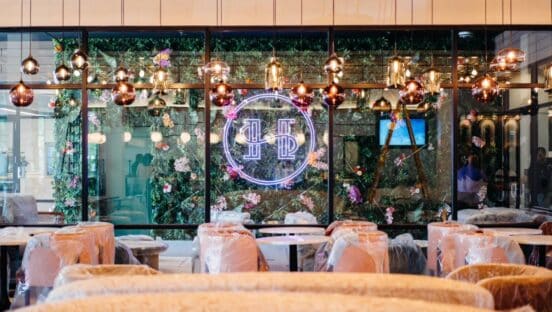Now more than ever, quick-service executives are opening their eyes to the wealth of opportunity that lies beyond U.S. borders, realizing that abroad is where the growth is—and for good reason.
“Domestic is one country; international is every other country,” says Bob Kaufman, vice president of business development for Southern California–based The Coffee Bean & Tea Leaf (CBTL).
“Of course international is huge, because of the sheer number of people and markets and opportunities.”
With overseas operations presenting such a vast array of markets and possibilities, this year’s Global 30 study not only breaks down the top brands in international franchising, but also the most notable trends, movements, and regions on the market.
The international environment
It’s not just the sheer size of the international playing field that has brands focusing on foreign markets. Though many operators insist the U.S. is still a major focal point for brand growth, some brands are reaching their saturation point domestically. This is especially true for big-time players like McDonald’s and Subway, which have more than 14,000 and 25,000 units, respectively, in the U.S. alone.
In addition, a tough economic climate at home has placed increasing pressure on brands to look elsewhere for revenue and avenues of growth.
“When the credit kind of crunched in the United States and franchisees weren’t able to get bank loans like they were years ago, brands were really saying to themselves, ‘We’re forced now to go international because we can’t sell franchises here,’” says Karen Spencer, partner at franchise consultant Fran-Systems.
Of course, the global economy is under some pressure, too, but a growing number of countries and consumers around the world are enchanted by the opportunity that franchising American brands presents. “Capitalism is spreading around the world, and a close cousin to capitalism is consumerism,” says Bob Wright, president and COO of Charley’s Grilled Subs. “There’s a growing middle class, growing disposable income, and a growing desire for Western brands and some of the Western culture that we take for granted here.”
Research shows many companies are taking advantage of this consumer desire. By 2020, the global franchise industry will be worth $5 trillion, and 50 percent of the top 200 franchised brands’ units will be overseas within a decade, says Beth Solomon, president and CEO of the National Association of Development Companies and former vice president of strategic initiatives and industry relations for the International Franchise Association.
At Domino’s Pizza, international operations already account for more than half of the brand’s global store count, as well as a significant portion of its royalty stream, writes Ritch Allison, executive vice president of international, in an e-mail to QSR.
But the abundance of opportunities doesn’t come without challenges. Unlike in the U.S., where expanding chains can take advantage of their established distribution channels, brands entering a new international market must often start from scratch.
“We go into a new market like Bahrain in the Middle East or Poland or Eastern Europe, and those are very difficult hurdles,” says Wright from Charley’s, which operates in more than 16 countries around the world. “You can spend upward of a year getting the supply chain up and running.”
Cracking foreign markets can also be expensive, time consuming, and risky, especially for young brands that have neither the capital nor the experience to survive in the international space, Spencer says.
The local flavor
Adapting to regional tastes can present a challenge when operating internationally, but brands can also use culture—both their own and their international market’s—to their advantage. Solomon says many foreign consumers are eager to embrace American brands and customs, making international markets fertile ground for U.S. concepts.
“These quick-service American brands give people in these countries a chance to taste it, feel it, see it, walk into the store,” she says. “They can experience American culture in a very direct way.” American brands are also highly esteemed in the minds of many cultures and represent superior, safe, and healthy food, Solomon says.
Wright says Charley’s capitalizes on this high-quality reputation by emphasizing its USDA Choice steak offerings internationally. But while the cheesesteak chain is known for its Choice products, it was forced to substantially alter its menu when entering the Middle East’s Islamic nations, switching to Halal-certified beef and eliminating bacon from many of its limited-time offerings.
Unfortunately, sacrifices like this can only go so far, and one country the brand hasn’t been able to tackle due to menu challenges is India.
“A lot of Indian culture is vegetarian. When you’re in the Philly Cheesesteaks business and your core menu is made up of cheese-steak sandwiches, … you’re no longer tweaking flavors. You’re changing the core of the menu,” Wright says. “It’s much more difficult to see a path to expanding in an area like that and yet still staying true to who we are and who the brand is.”
Jeremy Vitaro, vice president of international development for Dunkin’ Brands, writes in an e-mail to QSR that the company takes a country-to-country approach to menu localization. To speak to the Chinese customer, for example, Dunkin’ Donuts has added regional items like Mochi Ring Donuts—made with a glutinous rice—and bubble tea. At Baskin-Robbins, ice cream flavors such as Green Tea and Mango Mania resonate with the local palate.
Vitaro says adapting to some cultural differences can be more challenging than others, but the company relies on its international partners to tap into consumer tastes and trends. “We are able to leverage their knowledge of the local consumer to provide our guests with the right product mix and, in turn, position our brand for greater success in the market,” he writes.
Domino’s Allison says thriving international operations come down to these effective partnerships with strong local operators. “Growth in any market revolves around finding the right local partners,” he says. “We believe finding the right partners, teaching them the business, maintaining strong relationships, and providing them value for their investment is what works, no matter what market you’re talking about.”
While Charley’s has 210 franchisees in its system, it remains hypercritical when selecting its international affiliates.
“We want to go in knowing we’re signing a multiunit agreement with a partner that can help us develop in that region, somebody who knows how business works in that part of the world,” Wright says. “Somebody who has the experience with people, with the supply-chain needs, … and the ability to do business in the construction and real-estate environment.”
[pagebreak]
The hot markets
Many operators and experts agree that two markets stand out above the rest in today’s international scene: the Middle East and Asia.
Dozens of U.S.-based quick-serve brands have already staked claims in the Middle East, as the region’s growing sophistication, wealth, and interest in Western brands creates an environment ripe with opportunity.
“There’s a good deal of money in those markets, so people are sophisticated, they’ve traveled around the world, and they want an international standard in their shopping malls,” a main social gathering place for consumers in Middle Eastern markets, CBTL’s Kaufman says.
‘There’s a great opportunity for all kinds of brands in those markets, because it’s a market that’s trying to provide the best of the world’s retail.”
With more than 850 Dunkin’ Donuts and Baskin-Robbins locations in the Middle East—largely concentrated in Saudi Arabia, the United Arab Emirates, Lebanon, and Qatar—the region is one of Dunkin’ Brands’ largest international markets. Domino’s, meanwhile, recently opened its 200th store in the Middle East with its local master franchisee, Alamar Foods.
Because alcohol is largely shunned in the Middle East, the area provides an added bonus for beverage brands like CBTL, which operates in countries like Kuwait, Oman, and Egypt.
“The need for places to hang out is the same everywhere around the world. So if [consumers] are not going to hang out in a bar, they’re probably going to hang out in a coffee shop,” Kaufman says. “These are specific opportunities for our brand, in addition to the fact that those markets in particular are very receptive to internationally known and established brands.”
The other hot market today, Asia, has been similarly capitalized on by many quick serves. “[Asians] definitely love American brands,” Fran-Systems’ Spencer says. “There are more government restrictions in Asia, and I think that it’s not as easy of an entry, but they can’t ignore it because the number of requests to go there is just too high.”
Dunkin’s Vitaro says Asia is the largest international region for its brands, with a major focus on nations including South Korea, Japan, Thailand, and Indonesia. Domino’s Allison says his brand is growing strongly in Malaysia, Japan, and India.
While the rest of the world is struggling economically, many Asian economies are booming, giving Asian consumers more buying power than ever.
“When the economies are booming, [Asian consumers] have to work harder. And when they have to work harder, they just have less time,” says Wan Kim, global CEO of Smoothie King, a beverage brand with more than 130 stores in Korea and a growing presence in other Asian nations. This gives quick-service brands an opportunity to play an important role in consumers’ lives, Kim says, by offering fast, convenient service.
The China strategy
One Asian nation in particular has been the leading international hot spot for several years running: China. With the world’s largest population—surpassing 1.34 billion people in 2012, according to World Bank—China is one country most brands dream of taking a crack at.
But it may not be all it’s cracked up to be. Challenging government regulations, cultural barriers, labor and immigration issues, and staunch competition for consumers and real estate are all hurdles brands must clear to be successful in China.
“China is an enormous market full of opportunity,” Solomon says. “But China only makes sense if you really can take advantage of that economy of scale.” If brands don’t have the ability to open several units, China may not be worth the trouble, she adds.
For Yum! Brands’ KFC, the rewards are certainly worth the risk. With more than 4,000 locations in China alone, the fried-chicken chain pulls in almost half of its global revenue from the Asian superpower.
Because China is such a large and powerful market for limited-service brands, CBTL’s Kaufman says companies must flesh out specific plans for each region. “You can’t just say, ‘I want a China strategy,’” he says. “You need to understand what your Beijing strategy is versus your Shanghai strategy versus your airport strategy in China. You have to really understand the specific market you’re going into.”
Kim says Smoothie King is looking into markets like Shanghai, but will stick to company-owned stores in the nation, largely due to a lingering concern over sanitation.
“The sanitation awareness is not high yet [in China],” he says. “We want to make sure we only open company-owned stores and try to convince Chinese customers that we care about sanitation, we really care about our ingredients, we care about our products, so it’s safe.”
Not every brand is sold on China. Though the country presents a huge opportunity for chicken-wing concept Wingstop, the brand is instead aiming to expand in other Asian countries, including the Philippines, South Korea, and Vietnam.
“It’s a very difficult market to work in,” CEO and president Charlie Morrison says. “There’s less structure to how franchises are put in place in the country. There’s not a lot of structure and rules and security for the franchisor.”
To exercise caution when testing the waters in China, Vitaro says Dunkin’ isn’t rushing development. The company has almost 60 Dunkin’ Donuts units in the country, in addition to the more than 90 Baskin-Robbins locations, and is “focused on disciplined growth by finding the right partners for the right cities,” he says.




